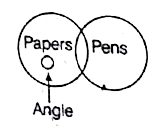Statemetns
I. Some papers are pens.
II. Angle is a paper.
Conclusion
I. Angle is not a pen.
II. Angle is a pen.
if only Conclusion I follows
if only Conclusion II follows
if either Conclusion I or II follows
if neither I nor II follows
The correct Answer is:C

This is a special case. So either Conclusion II follows.
Topper's Solved these Questions
- BOOK - ARIHANT PUBLICATIONCHAPTER - SYLLOGISMEXERCISE - LET US PRACTICE (EXPERT LEVEL EXERCISE)11videos
SYLLOGISM
- BOOK - ARIHANT PUBLICATIONCHAPTER - SYLLOGISMEXERCISE - LET US PRACTICE (EXPERT LEVEL EXERCISE)11videos
SYLLOGISM
- BOOK - ARIHANT PUBLICATIONCHAPTER - STATEMENT AND COURSE OF ACTION EXERCISE - LET US PRACTICE (B EXPERT LEVEL EXERCISE)11videos
STATEMENT AND COURSE OF ACTION
- BOOK - ARIHANT PUBLICATIONCHAPTER - VERIFICATION OF TRUTH OF THE STATEMENT EXERCISE - LET US PRACTICE30videos
VERIFICATION OF TRUTH OF THE STATEMENT
Similar Questions
In given question below are two statements followed by two conclusions numbered I and II. You have to take the given two statements to be true even if they seen to be at variance from commonly know facts. Read the conclusions logically follows the two given statement, disregarding commonly know facts.
Give answer
(a) if only conclusion I follows,
(b) if only conclusion II follows,
(c) if either conclusion I or II follows,
(d) if neither conclusion I nor II follows,
(e) if both conclusion I and II follows.
Statements : Some papers are pens. Angle is a paper.
Conclusions : I. Angle is not a pen.
II. Angle is a pen.View SolutionIn given question below are two statements followed by two conclusions numbered I and II. You have to take the given two statements to be true even if they seen to be at variance from commonly know facts. Read the conclusions logically follows the two given statement, disregarding commonly know facts.
Give answer
(a) if only conclusion I follows,
(b) if only conclusion II follows,
(c) if either conclusion I or II follows,
(d) if neither conclusion I nor II follows,
(e) if both conclusion I and II follows.
Statements : Some papers are pens. Some pencils are pens.
Conclusions : I.Some pens are pencils.
II. Some pens are papers.View Solution
Knowledge Check
- Question 1 - Select One
Statements: 1. Some papers are pens.
2. Angle is a paper.
Conclusions: 1. Angle is not a pen.
2. Angle is a pen.AIf only conclusion I follows,BIf only conclusion 2 follows,CIf either conclusion 1 or 2 follows,DIf neither conclusion 1 nor 2 follows, - Question 2 - Select One
Statements: 1. Some papers are pens
2. Angle is a paper
Conclusions: 1. Angle is not a pen
2. Angle is a penAif only conclusion 1 follows,Bif only conclusion 2 follows,Cif either conclusion 1 or 2 follows,Dif neither conclusion 1 nor 2 follows, - Question 3 - Select One
Statements : Some papers are needles.
All nedles are sharp.
Conclusion : I All papers are sharp.
II . All nedles are papers.Aif only conclusion I followsBif only conclusion II followsCif either I or II followsDif neither I nor II follows and
Statements:
Some caps are pens
All pens are paper
Conclusions:
I. All pens which are caps are paper
II. Some pens are capsView SolutionStatements: 1. Some papers are pens
2. Some pencils are pens
Conclusions: 1. Some pens are pencils
2. Some pens are papersView SolutionTwo statements are given, each followed by two Conclusions/Assumptions I and II. You have to consider the statement to be true even if they seem to be variance from commonly known facts. You have to decide which of the given conclusions/assumptin, if any, follows from the given statements.
Statements :
(i) Some papers are pens.
(ii) All the pencils are pens.
Conclusions :
I. Some pens are pencils.
II. Some pens are papers.View SolutionStatements: Some pens are cups. No cups are plates.
Conclusions: I. Some pens are not plates. II. All pens are plates. III. Some plates are not pens.View SolutionIn the following question below are given some statements followed by some conclusions. Taking the given statements to be true even if they seem to be at variance from commonly known facts, read all the conclusions and then decide which of the given conclusion logically follows the given statements.
Statements:
I. Some pens are pencils.
II. Some pencils are cups.
Conclusions:
I. Some cups are pens.
II. Some pencils are pensView Solution

